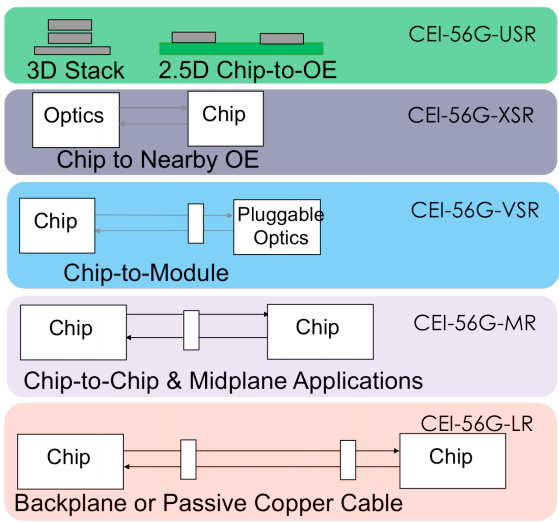High-Speed Interfaces and the Ethernet Switch Evolution
Technology development has always been driven by emerging applications: big data, Internet of Things, machine learning, public and private clouds, augmented reality, 800G Ethernet, etc.
Merchant Silicon switch ASIC chip development is an excellent example of that golden rule.
OIF’s Common Electrical Interface Development
The Optical Internetworking Forum (OIF) is the standards body – a nonprofit industry organization – that develops common electrical interfaces (CEIs) for next-generation technology to ensure component and system interoperability.
The organization develops and promotes implementation agreements (IAs), offering principal design and deployment guidance for a SerDes (serializer-deserializer), including:
- CEI-6G (which specifies the transmitter, receiver and interconnect channel associated with 6+ Gbps interfaces)
- CEI-11G (which specifies the transmitter, receiver and interconnect channel associated with 11+ Gbps interfaces)
- CEI-28G (which specifies the transmitter, receiver and interconnect channel associated with 28+ Gbps interfaces)
- CEI-56G (which specifies the transmitter, receiver and interconnect channel associated with 56+ Gbps interfaces)

Source: OIF
OIF’s CEI specifications are developed for different electrical interconnect reaches and applications to ensure system service and connectivity interoperability at the physical level:
- USR: Ultra-short reach, for < 10 mm die to optical engine within a multi-chip module (MCM) package.
- XSR: Extremely short reach, for < 50 mm chip to nearby optical engine (mid-board optics); or CPU to CPU/DSP arrays/memory stack with high-speed SerDes.
- VSR: Very short reach, < 30 cm chip (e.g. switch chip) to module (edge pluggable cage, such as SFP+, QSFP+, QSFP-DD, OSFP, etc.).
- MR: Middle reach, < 50 cm for two chips on the same PCB assembly or on a daughter card, or mid-plane, which could include a single connector.
- LR: Long reach, < 1 m for communication interface between two cards across a backplane, with up to two connectors; cabled solution (twin-axial copper cable backplane) and chassis-to-chassis interconnects.
System-level interconnects (server to switch, switch to switch and switch to router) employ predominantly edge-pluggable modules (with copper and fiber cable) for easy failure replacement and pay-as-you-go deployment, enabled by chip-to-module VSR implementation agreements.
Ethernet Switch Evolution with Pluggable Modules
Currently, switch ASICs with 3.2 Tbps throughput (e.g. Broadcom Tomahawk) support a mainstream 1 RU 32-port (QSFP28) 100G Ethernet switch.
To achieve 6.4 Tbps, 9.6 Tbps and 12 Tbps throughput in a 1 RU switch, QSFP-DD or OSFP can help get there earlier; eight-lane pluggable modules reuse the same technology that was developed for four-lane QSFP28 modules, with double the amount of bandwidth. Both QSFP-DD and OSFP can support 200G and 400G Ethernet with a pluggable module.

Merchant Silicon switch ASIC chip development roadmap
QSFP-DD and OSFP have both been embraced and adopted by major industry leaders (connectivity, optical component and system vendors) and end-users (cloud service providers). A few differences to note:
- OSFP is slightly larger and supports a higher power envelope (up to 16W) per pluggable module for Top of Rack (ToR), spine, leaf and data center interconnect (DCI) applications.
- QSFP-DD has a relatively smaller power envelope (up to 14W) but offers other advantages, such as backward compatibility with QSFP28 and a smaller form factor.

Evolution of a 1 RU rack switch faceplate density and throughput (Click to enlarge)
Make sure to subscribe to our blog updates to find out what else is set to change as we keep head down the road to 800G Ethernet. We’ll be covering topics like:
- Layer 0 copper connectivity
- Layer 0 fiber connectivity
- The ubiquity of 100G Ethernet
- Optical fiber cabling migration toward 100G, 200G, 400G and 800G Ethernet
Belden’s copper and fiber solutions will help you get your data center ready for the road to 800G. And don’t forget to download our new application note about getting ready for new fiber infrastructure in your data center!
